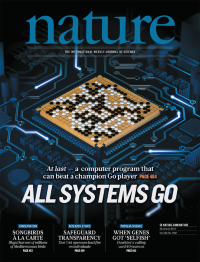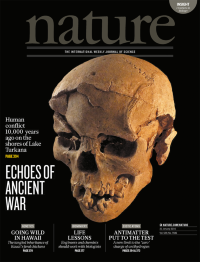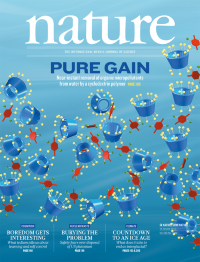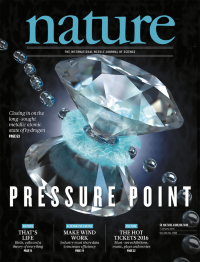Volume 529
-
No. 7587 28 January 2016
A Go board depicted as a computer chip embedded on an integrated circuit board. The layout is taken from the final position of the historic Go game played on 5 October 2015 between Fan Hui (black stones) and AlphaGo (white), representing the first time a computer program has ever beaten a professional player on a full, 19 19 board, in even games with no handicap. The victory in 1997 of the chess-playing computer Deep Blue in a six-game series against the then world champion Gary Kasparov was seen as a significant milestone in the development of artificial intelligence. An even greater challenge remained � the ancient game of Go. Despite decades of refinement, until recently the strongest computers were still playing Go at the level of human amateurs. Enter AlphaGo. Developed by Google DeepMind, this program uses deep neural networks to mimic expert players, and further improves its performance by learning from games played against itself. AlphaGo has achieved a 99% win rate against the strongest other Go programs, and defeated the reigning European champion Fan Hui 5�0 in a tournament match. Cover: Google DeepMind
-
No. 7586 21 January 2016
A skull from Nataruk, northern Kenya, showing the traumatic lesions that caused this mans death. Violence and warfare have shaped human societies for many thousands of years, but the origins of inter-group conflict in the archaeological record are controversial, dependent on how such conflicts are defined and recognized, as well as on the lottery of preservation. Marta Mirazón Lahr et al. report fossil finds that point to a case of inter-group violence among hunter-gatherers in the early Holocene. Ten out of twelve skeletons, discovered near what was once a small lagoon, show evidence of having undergone violent deaths. There were no signs of deliberate burial, and several individuals have multiple major traumatic lesions including an obsidian bladelet embedded in one of the skulls. The authors interpret this assemblage as the aftermath of a violent inter-group encounter that took place some 10,000 years ago on the fertile shores of Lake Turkana. Cover: Marta Mirazón Lahr & Fabio Lahr.
-
No. 7585 14 January 2016
A representation of a high-surface-area, mesoporous polymer of β-cyclodextrin. Water purification and remediation is often carried out using various forms of activated carbon; it is inexpensive, but only partially removes many organic pollutants. However, regenerating activated carbon for reuse is energy intensive, requiring high temperatures, and performance decreases upon recycling. Now William Dichtel, Damian Helbling and colleagues have developed an alternative to activated carbon for water remediation: a porous material based on crosslinked cyclodextrins. Not only does the material outperform activated carbons at adsorbing a range of pharmaceuticals, pesticides and other pollutants, but it is easily regenerated by washing at room temperature. Cover: Michio Matsumoto & Scarlet Duba
-
No. 7584 7 January 2016
An artistic impression of hydrogen molecules from their dielectric molecular state at moderate compressions (transparent molecules), through to the onset of its proposed pressure-induced metallization (metallic atoms). Under extremely high pressures, hydrogen molecules are predicted to break down and form a metallic atomic state. Such a state has yet to be realized, but new results from a team at the University of Edinburgh could be getting us closer to this goal. They have now managed to squeeze hydrogen molecules (and their deuterated equivalents) to pressures in excess of 3.5 million atmospheres, and see tantalizing hints of a new phase � possibly a precursor to the long-sought non-molecular phase. Cover: Philip Dalladay-Simpson




